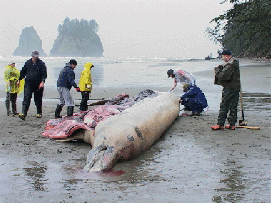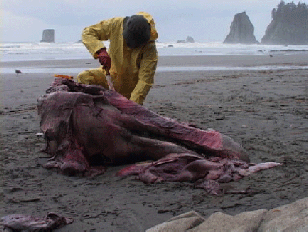|
On Tuesday, 28 January 2003, a large beaked whale
carcass was reported to have washed ashore on
Second Beach at La Push, WA. The Northwest
regional marine mammal stranding network
dispatched Ken Balcomb (Center for Whale Research,
Friday Harbor), Todd Chandler (Cascadia Research
Collective, Olympia), Laurie Hopkins (NMFS) and
Dr. Stephen Raverty (DVM Pathologist, Abbotsford,
BC) to the scene to identify the species, collect
specimen materials, and determine the cause of death,
if possible.
The stranding response team arrived on scene in mid-day as the tide ebbed on 30 January and performed a necropsy on site.
The whale was 11.77 meters (38 feet) in length, identified as a Baird’s beaked whale, of undetermined sex and age.
The genital region had extruded and decomposed, and gonads were not located; but, tissue chromosomes will later be analyzed to determine sex, and laminations in the cemental layers of a tooth will be analyzed to determine age.
The stomach contained bony remains of many small fish, and the blubber thickness indicated that the whale had been feeding and was in good body condition immediately prior to death.
Tissues will be examined for any evidence of disease process. The right shoulder blade and many ribs were broken, some internal organs were displaced, and the head and acoustic fats in the mandibles and forehead were seeping blood.
Although it was not determined in the field if these traumas were antemortem or postmortem (before or after death), that may be evident from analysis of collected specimen materials.
Grossly, the evidence suggests massive blunt trauma, for example from ship strike or explosion nearby. If the whale suffered a ship strike while alive, this would be the first record of such an incident involving a beaked whale species that is normally shy and avoiding of vessel traffic.
In any case, this whale represents the second record of Baird’s beaked whale from Washington State, the first being noted by Slipp and Wilke (1953) of this uncommon deep diving North Pacific whale species.
The entire whale is estimated to have weighed twelve tons and could not be moved by the response team, but the head (weighing approximately 700 pounds) was removed and dragged above the high tide line for later examination. Rising tide, storm conditions, and approaching darkness precluded further examination on 30 January, and most of the response team departed around dusk.
On 31 January 2003, Ken Balcomb returned at
mid-day to further examine the whale and
collect the ear bones, which could provide
additional evidence concerning whether the
whale had experienced an intense pressure
trauma in vivo (while living). This is very
important to ascertain because beaked whales
seem to be especially sensitive to pressure
trauma, such as are experienced during
underwater explosions, seismics, and sonar
operations.
[It is extremely interesting, and perhaps germane to note that the US aircraft carrier, USS "Carl Vinson" (CVN70)" and its frigate escort, USS "Ingraham" (FFG61) departed Puget Sound on or around 22 January, 2003 for two weeks of sustainment training in the eastern Pacific prior to arriving in Honolulu on 2 February 2003; see http://www.cvn70.navy.mil
I do not know if active sonar was employed during the transit phase of this deployment, but "Ingraham" is equipped with ANSQS56 mid-frequency sonar, which is capable of producing 6.8-8.2 kHz "pings" at a nominal source level of 223 dB (at least).
We had noted that "pings" of high intensity medium frequency were recorded from the Sea Sound hydrophones in Haro Strait on 22 January, as an aircraft carrier was observed heading west in the eastern Strait of Juan de Fuca late in the day; but, we do not know if this was USS "Carl Vinson" and escorts.
It is further interesting, and perhaps germane, to note that there is a US Naval exercise area nearby, designated W237, within the Olympic Coast National Marine Sanctuary, just offshore of La Push, Washington. There should be records available if there was exercise activity in this area around this time, and if so what was the nature of that activity. This could shed light on the tremendously important topic of sonar impacts on marine mammals in Washington State and throughout the world.]
The earbones will be subjected to Computerized Tomography (CT) scans and subsequently decalcified and examined histologically. Specifically, the presence of eosinophilic precipitate (indicating an antemortem insult), blood in primarily the apex and base of the cochlea (suggesting a neural canal and CSF entry to the ear), loss of auditory neurons and metabolic tissues, and labyrinthine collapse", if present, would be consistent with impulse trauma as previously demonstrated in beaked whales as a result of sonar operations.
Alternatively, the whale could have experienced an unexpected and immaculate death, and simply bashed onto the rocks before stranding on the sandy beach.
Ref: Slipp, J. and Wilke, F., 1953. The beaked whale Berardius on the Washington coast. J. mamm. 34, 105-113.
Draft Report dated 2 February 2003 by Kenneth C. Balcomb,
III Senior Scientist,
Center for Whale Research,
PO Box 1577, Friday Harbor, WA 98250.
Top
|

